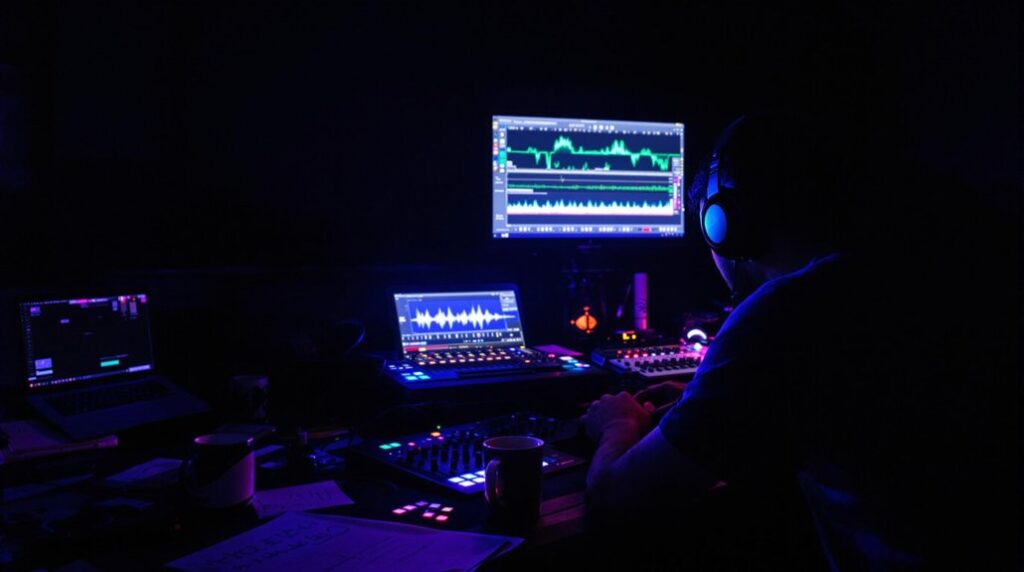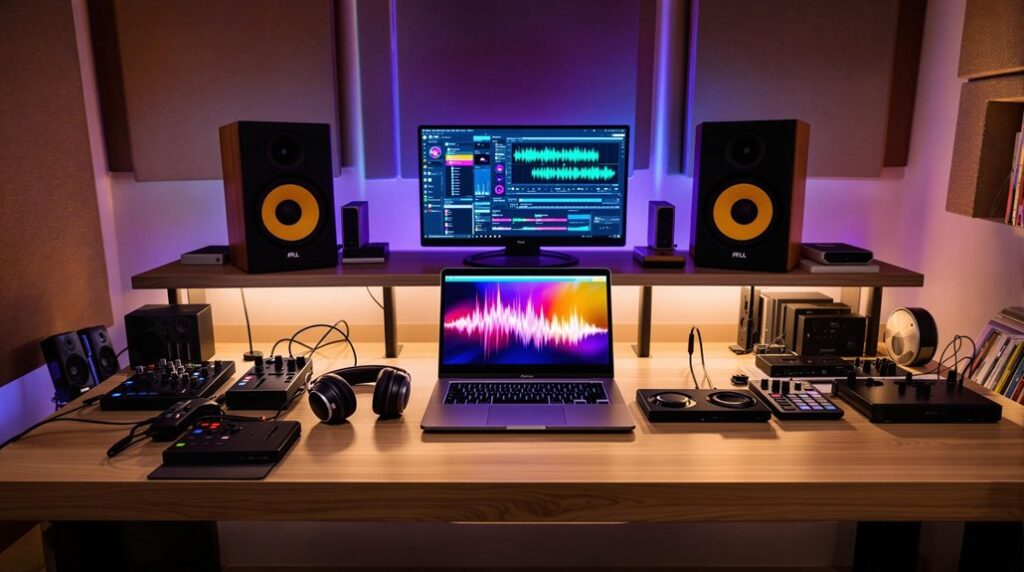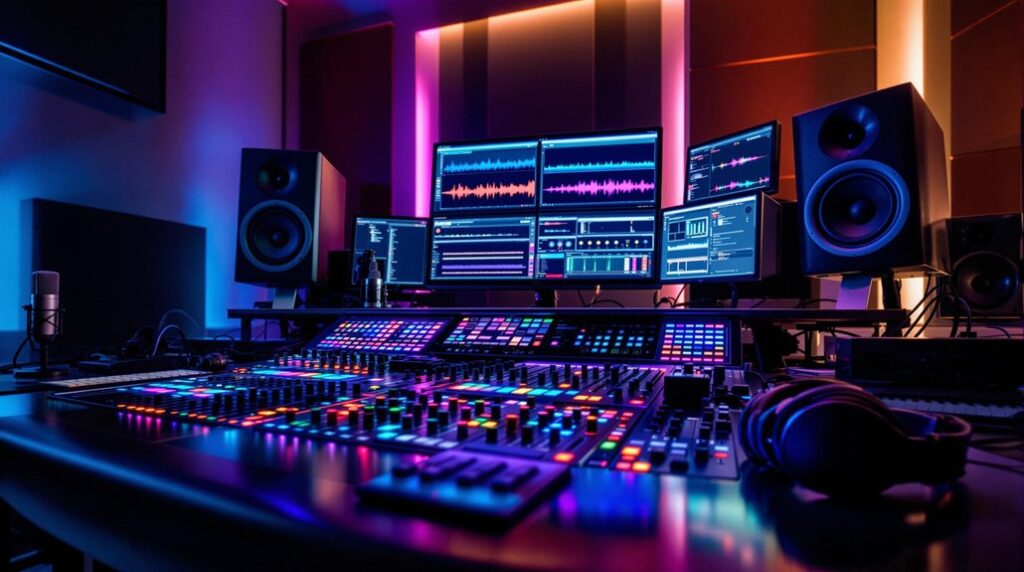Understanding frequency is essential for mastering audio mixing. You’ll manipulate sub-bass (20-60 Hz) for depth and power, and bass (60-250 Hz) to anchor the rhythm. In the low-mids (250-500 Hz), avoid muddiness while ensuring warmth. Midrange (500 Hz-2 kHz) adds definition and presence, while high-mids (2 kHz-6 kHz) enhance articulation. Use EQ to boost or attenuate frequencies, managing textures and eliminating unwanted sounds. Proper adjustments in high frequencies (6 kHz-20 kHz) add brilliance and clarity. Subtle frequency boosts and cuts shape your mix into a polished masterpiece. Keep going to understand how precise tweaks enhance your work.
Key Takeaways
- Proper frequency management ensures a balanced and polished mix.
- EQ adjustments allow boosting or cutting frequencies for optimal sound quality.
- Midrange frequencies are crucial for instrument clarity and presence.
- Sub-bass and bass frequencies provide the mix’s foundation and rhythmic bedrock.
- High frequencies add brilliance and airiness to the overall sound.
Frequency Ranges Overview
Understanding frequency ranges is essential for achieving a balanced and professional mix. In music production, the frequency spectrum is divided into several key ranges that each serve a specific purpose.
Sub-bass, ranging from 20 Hz to 60 Hz, forms the foundation of your mix, delivering those deep, felt vibrations that are more sensed than heard. This range is pivotal for adding depth and power.
Moving up, bass frequencies span from 60 Hz to 250 Hz. These frequencies underpin the rhythm section and add warmth to your mix. Properly managing this range is essential in audio engineering to make sure that your mix doesn’t sound thin or lacking in body.
Low-mids, from 250 Hz to 500 Hz, are where muddiness or boxiness can easily creep in. Careful balancing in this range is necessary to maintain clarity and prevent your mix from sounding congested.
The midrange, from 500 Hz to 2 kHz, is indispensable for instrument definition and presence. This is where the core of many instruments lies, making it crucial for clarity.
High-mids, spanning 2 kHz to 6 kHz, contribute to the attack and articulation of instruments, enhancing the overall definition and presence in your mix. Properly managing these ranges with precise mixing techniques will ensure a polished, professional sound.
Impact on Audio Mixing
Mastering the manipulation of frequency ranges is vital for achieving a balanced mix that guarantees each instrument occupies its unique sonic space. By applying precise frequency manipulation techniques, you can carve out space for each element, ensuring instrument clarity.
Equalization (EQ) adjustments are integral to this process, allowing you to boost or attenuate specific frequency bands to highlight or diminish certain aspects of the audio spectrum.
Midrange frequencies, typically between 250 Hz and 5 kHz, are particularly important. They contribute significantly to the texture and prominence of instruments like guitars, vocals, and snare drums. Properly managing these frequencies ensures instruments don’t mask each other, maintaining clarity and preventing a muddy mix.
High-pass and low-pass filters further aid in frequency manipulation by removing unwanted low or high-end content, thereby reducing frequency overlap. This technique is especially useful for decluttering the mix and focusing the listener’s attention on the essential elements.
Ultimately, meticulous frequency management is essential for an articulate, polished mix. By skillfully manipulating frequencies, you can enhance the overall balance, ensuring each instrument is distinct, contributing to a cohesive and professional sound.
Sub-Bass to Highs
Examining the spectrum from sub-bass to highs, you’ll find that each frequency range, from the sub-bass’s 20 Hz rumble to the high frequencies’ 20 kHz sheen, plays an essential role in sculpting a mix’s texture and depth. Understanding these ranges enables precise sound design and effective frequency manipulation.
- Sub-Bass (20-60 Hz): This range provides the deepest, most guttural frequencies, essential for bass-heavy instruments. It underpins the track with a powerful foundation, often felt more than heard.
- Bass (60-250 Hz): The bass frequencies form the rhythmic bedrock. They carry the groove and drive of the music, essential for harmonic balance and the overall body of the mix.
- Low-Mid (250-500 Hz): This spectrum adds warmth and fullness. Mismanagement here can lead to a muddy mix, but careful handling enhances clarity and richness, balancing other frequency elements.
- High Frequencies (6 kHz-20 kHz): These frequencies impart brilliance and airiness, adding detail and presence. They enhance the mix’s intelligibility and sparkle, vital for creative effects and subtle nuances.
EQ Adjustments
Crafting effective EQ adjustments involves meticulously boosting or cutting specific frequency bands to sculpt the sonic landscape and guarantee each instrument occupies its own space in the mix. Utilizing advanced EQ techniques can address frequency masking, a common issue where overlapping frequencies cause instruments to maintain their distinctiveness. By precisely targeting problem areas, you can troubleshoot and enhance the clarity of your mix.
For instance, boosting midrange frequencies (500 Hz – 2 kHz) allows instruments to cut through without introducing muddiness. Balancing frequencies in this range assures the mix remains clear and articulate.
To enhance the attack and presence of instruments, you should focus on the upper midrange (2 kHz – 6 kHz). Adjusting these frequencies can add definition and presence, making elements like vocals and guitars more prominent.
On the higher end of the spectrum, tweaking frequencies between 6 kHz and 20 kHz can introduce brilliance and airiness. However, this must be done judiciously to avoid harshness or excessive sibilance.
Skillful EQ adjustments involve a nuanced approach to balancing frequencies, ensuring each instrument retains its unique character while contributing to a cohesive overall mix.
Enhancing Instruments
Enhancing instruments in a mix necessitates accurate manipulation of frequency bands to guarantee each element occupies its ideal sonic space. To achieve peak instrument clarity and sound enhancement, you must employ precise frequency boosts and cuts to maintain mix balance.
Here are some essential techniques:
- Boosting Low Frequencies:
- A 60 Hz boost for kick drums adds depth, enhancing their presence. This low-end enhancement guarantees the kick cuts through the mix without overpowering.
- Notching Frequencies for Bass:
- Cutting around 80 Hz on bass guitars prevents muddiness. This technique allows other instruments to shine, contributing to a cleaner, more defined mix.
- Enhancing Guitars:
- Notching 100 Hz on electric guitars can provide clarity and separation. This frequency cut avoids conflicts with bass and kick, ensuring each instrument maintains its unique space.
- Mid-High Frequency Bumps:
- A 4 dB bump around 4K for toms can enhance their presence and impact. This targeted boost brings out the toms’ attack, making them more prominent in the mix.
Frequently Asked Questions
What Are the Important Frequencies for Mixing?
You need to focus on sub-bass (20-60 Hz), bass (60-250 Hz), midrange (500 Hz-2 kHz), and high frequencies (6 kHz-20 kHz). Use EQ techniques to prevent frequency masking and guarantee clarity and balance.
What Is the Best Frequency Response for Mixing?
You need a flat frequency response across the frequency spectrum for ideal mixing. Room acoustics should be carefully managed to minimize deviations, ensuring accurate audio representation and aiding in precise mix decisions for professional-grade sound quality.
What Is Frequency in Sound Mixer?
Frequency in a sound mixer refers to the frequency spectrum you can adjust using equalization techniques. You control specific bands like bass, midrange, and treble, enabling precise tonal shaping for clarity and balance in your mix.
What Is the Understanding of Frequency in Music Production?
You need to grasp the frequency spectrum and harmonic content in music production. This knowledge lets you make precise EQ adjustments, ensuring each instrument’s clarity and separation, ultimately achieving a balanced and professional mix.
Conclusion
In audio mixing, understanding frequency ranges – from sub-bass to highs – is paramount. Mastery of EQ adjustments allows you to sculpt each instrument’s presence, ensuring clarity and balance.
By precisely enhancing specific frequency bands, you can achieve a polished, professional mix. Remember, the interplay between frequencies defines your mix’s sonic character.
Utilize your technical expertise to manipulate these elements, creating a cohesive and dynamic auditory experience. Your proficiency in frequency manipulation is the cornerstone of superior mixing.




